
See also:
- Fun, fun, tensors: Tensor Constants, Variables and Attributes, Tensor Indexing, Expanding and Manipulations, Matrix multiplications, Squeeze, One-hot and Numpy
- Tensorflow 2 - Neural Network Regression: Building a Regression Model, Model Evaluation, Model Optimization, Working with a "Real" Dataset, Feature Scaling
- Tensorflow 2 - Neural Network Classification: Non-linear Data and Activation Functions, Model Evaluation and Performance Improvement, Multiclass Classification Problems
- Tensorflow 2 - Convolutional Neural Networks: Binary Image Classification, Multiclass Image Classification
- Tensorflow 2 - Transfer Learning: Feature Extraction, Fine-Tuning, Scaling
- Tensorflow 2 - Unsupervised Learning: Autoencoder Feature Detection, Autoencoder Super-Resolution, Generative Adverserial Networks
Tensorflow Neural Network Classification
Multiclass Classifications
Working with the MNIST Fashion Dataset -> 60k images / 10 classes
# importing the mnist dataset with keras
(train_data, train_labels), (test_data, test_labels) = tf.keras.datasets.fashion_mnist.load_data()
train_data.shape, test_data.shape
# ((60000, 28, 28), (10000, 28, 28)) => 60k training images & 10k testing images with 28x28px
# show example data
## training labels
class_names = ["T-shirt/Top", "Trousers", "Pullover", "Dress", "Coat", "Sandal", "Shirt", "Sneaker", "Bag", "Ankle Boot"]
## print label and data for index 666
print(f"Training Label:\n{class_names[train_labels[666]]}\n")
print(f"Training Data:\n{train_data[666]}")
plt.imshow(train_data[666], cmap=plt.cm.binary)
plt.title(class_names[train_labels[666]])
# Training Label:
# Sneaker
# Training Data:
# [[ 0 0 0 0 0 0 0 0 0 0 0 0 0 0 0 0 0 0 0 0 0 0 0 0 0 0 0 0]
# [ 0 0 0 0 0 0 0 0 0 0 0 0 0 0 0 0 0 0 0 0 0 0 0 0 0 0 0 0]
# [ 0 0 0 0 0 0 0 0 0 0 0 0 0 0 0 0 0 0 0 0 0 0 0 0 0 0 0 0]
# [ 0 0 0 0 0 0 0 0 0 0 0 0 0 0 0 0 0 0 0 0 0 0 0 0 0 0 0 0]
# [ 0 0 0 0 0 0 0 0 0 0 0 0 0 0 0 0 0 0 0 0 0 0 0 0 0 0 0 0]
# [ 0 0 0 0 0 0 0 0 0 0 0 0 0 0 0 0 0 0 0 0 0 0 0 0 0 0 0 0]
# [ 0 0 0 0 0 0 0 0 0 0 0 0 0 0 0 0 0 0 0 0 0 0 0 0 0 0 0 0]
# [ 0 0 0 0 0 0 0 0 0 0 0 0 0 0 0 0 0 0 0 0 0 0 0 0 0 0 0 0]
# [ 0 0 0 0 0 0 0 0 0 0 0 2 0 0 0 25 51 0 5 0 0 0 0 0 0 0 0 0]
# [ 0 0 0 0 0 0 0 0 0 0 0 0 2 72 74 115 175 7 0 7 5 0 2 0 146 110 7 0]
# [ 0 0 0 0 0 0 0 0 0 0 0 54 95 92 123 77 123 72 20 0 0 0 0 0 255 136 51 0]
# [ 0 0 0 0 0 0 2 0 2 38 79 97 118 90 105 121 95 115 128 59 48 5 5 64 118 103 82 0]
# [ 0 0 0 0 0 5 2 0 61 121 108 92 115 162 167 162 175 133 105 113 144 133 110 133 144 146 141 2]
# [ 2 0 0 0 0 0 5 36 113 103 95 118 128 126 110 108 151 182 195 167 139 136 136 115 126 108 123 2]
# [ 0 0 2 0 7 33 51 85 105 123 128 92 90 79 108 133 103 121 162 170 193 206 151 126 123 123 118 5]
# [ 5 33 48 59 72 74 82 82 115 123 121 118 139 115 90 133 139 136 149 164 180 170 157 170 151 139 131 2]
# [ 61 136 113 90 95 92 100 108 103 103 113 126 133 164 170 146 157 149 115 87 72 82 110 123 128 131 100 0]
# [ 41 79 118 159 149 139 136 131 113 110 113 118 113 79 85 43 15 25 36 38 51 59 41 41 41 36 54 0]
# [ 46 66 30 28 28 23 28 25 23 28 30 36 38 54 56 66 92 100 97 92 82 72 77 66 69 74 85 15]
# [ 0 20 54 69 72 72 79 82 79 82 79 82 82 72 82 87 74 72 74 64 54 54 56 51 56 54 51 7]
# [ 0 0 0 0 0 0 0 0 0 0 0 0 0 0 0 0 0 0 0 0 0 0 0 0 0 0 0 0]
# [ 0 0 0 0 0 0 0 0 0 0 0 0 0 0 0 0 0 0 0 0 0 0 0 0 0 0 0 0]
# [ 0 0 0 0 0 0 0 0 0 0 0 0 0 0 0 0 0 0 0 0 0 0 0 0 0 0 0 0]
# [ 0 0 0 0 0 0 0 0 0 0 0 0 0 0 0 0 0 0 0 0 0 0 0 0 0 0 0 0]
# [ 0 0 0 0 0 0 0 0 0 0 0 0 0 0 0 0 0 0 0 0 0 0 0 0 0 0 0 0]
# [ 0 0 0 0 0 0 0 0 0 0 0 0 0 0 0 0 0 0 0 0 0 0 0 0 0 0 0 0]
# [ 0 0 0 0 0 0 0 0 0 0 0 0 0 0 0 0 0 0 0 0 0 0 0 0 0 0 0 0]
# [ 0 0 0 0 0 0 0 0 0 0 0 0 0 0 0 0 0 0 0 0 0 0 0 0 0 0 0 0]]
# plot multiple random images with labels
ran_gen = np.random.default_rng()
plt.figure(figsize=(12, 12))
for i in range(12):
ax = plt.subplot(4, 4, i+1)
random_index = ran_gen.integers(low=0, high=59999, size=1)
plt.imshow(train_data[random_index[0]], cmap=plt.cm.binary)
plt.title(class_names[train_labels[random_index[0]]])
plt.axis(False)
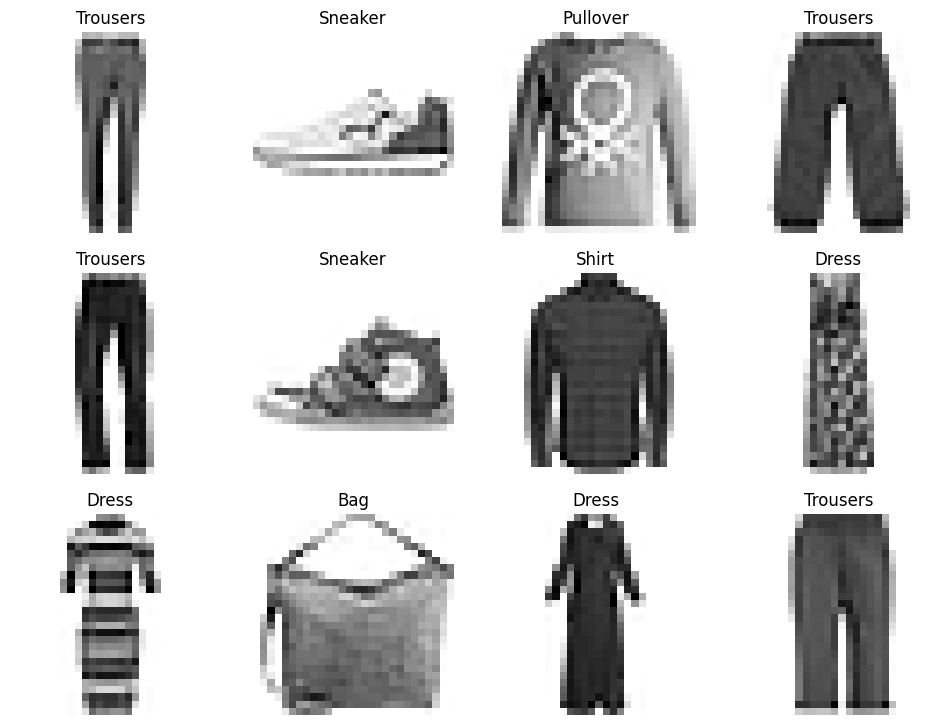
Multiclass Classification Model
- Input Shape: Shape of the input image -> train_data[0].shape =
(28, 28) - Output Shape: Number of labels -> len(np.unique(train_labels)) =
10 - Loss Function:
tf.keras.losses.CategoricalCrossentropy - Output Layer Activation:
softmax
# determin the input and output shape
train_data[0].shape, len(np.unique(train_labels))
# ((28, 28), 10)
# building the model - 1st attempt
tf.random.set_seed(42)
model_multiclass = tf.keras.Sequential([
tf.keras.layers.Dense(4, activation="relu", name="input_layer"),
tf.keras.layers.Dense(4, activation="relu", name="dense_layer1"),
tf.keras.layers.Dense(10, activation="softmax", name="output_layer")
])
model_multiclass.compile(loss=tf.keras.losses.CategoricalCrossentropy(),
optimizer=tf.keras.optimizers.Adam(learning_rate=0.0001),
metrics="accuracy")
history_multi = model_multiclass.fit(train_data, train_labels, batch_size=32,
validation_data=(test_data, test_labels),
epochs=100, verbose=1)
# ValueError: Shapes (32,) and (32, 28, 10) are incompatible
# => input data needs to be flattened
# building the model - 2nd attempt
tf.random.set_seed(42)
model_multiclass = tf.keras.Sequential([
# flatten data from `28*28` => `None, 784`
tf.keras.layers.Flatten(input_shape=(28, 28)),
tf.keras.layers.Dense(4, activation="relu", name="input_layer"),
tf.keras.layers.Dense(4, activation="relu", name="dense_layer1"),
tf.keras.layers.Dense(10, activation="softmax", name="output_layer")
])
model_multiclass.compile(loss=tf.keras.losses.CategoricalCrossentropy(),
optimizer=tf.keras.optimizers.Adam(learning_rate=0.0001),
metrics="accuracy")
history_multi = model_multiclass.fit(train_data, train_labels, batch_size=32,
validation_data=(test_data, test_labels),
epochs=100, verbose=1)
# ValueError: Shapes (32, 1) and (32, 10) are incompatible
# => CategoricalCrossentropy() expects labels to be OneHot encoded
# use SparseCategoricalCrossentropy() instead
Use
SparseCategoricalCrossentropy()for "regular" labels
# building the model - 3rd attempt (works!)
tf.random.set_seed(42)
model_multiclass = tf.keras.Sequential([
# flatten data from `28*28` to `None, 784`
tf.keras.layers.Flatten(input_shape=(28, 28)),
tf.keras.layers.Dense(4, activation="relu", name="input_layer"),
tf.keras.layers.Dense(4, activation="relu", name="dense_layer1"),
tf.keras.layers.Dense(10, activation="softmax", name="output_layer")
])
model_multiclass.compile(loss=tf.keras.losses.SparseCategoricalCrossentropy(),
optimizer=tf.keras.optimizers.Adam(learning_rate=0.0001),
metrics="accuracy")
history_multi = model_multiclass.fit(train_data, train_labels, batch_size=32,
validation_data=(test_data, test_labels),
epochs=100, verbose=1)
# Epoch 100/100
# 1875/1875 [==============================] - 3s 2ms/step - loss: 1.0307 - accuracy: 0.5697 - val_loss: 1.0820 - val_accuracy: 0.5568
Use
CategoricalCrossentropy()for OneHot encoded labels
# building the model - with OneHot encoded labels (alternative)
## OneHot encode labels
train_labels_hot = tf.one_hot(train_labels, depth=10)
test_labels_hot = tf.one_hot(test_labels, depth=10)
## re-run model with CategoricalCrossentropy() and ecoded labels
tf.random.set_seed(42)
model_multiclass_OneHot = tf.keras.Sequential([
# flatten data from `28*28` to `None, 784`
tf.keras.layers.Flatten(input_shape=(28, 28)),
tf.keras.layers.Dense(4, activation="relu", name="input_layer"),
tf.keras.layers.Dense(4, activation="relu", name="dense_layer1"),
tf.keras.layers.Dense(10, activation="softmax", name="output_layer")
])
model_multiclass_OneHot.compile(loss=tf.keras.losses.CategoricalCrossentropy(),
optimizer=tf.keras.optimizers.Adam(learning_rate=0.0001),
metrics="accuracy")
history_multi_OneHot = model_multiclass_OneHot.fit(train_data, train_labels_hot, batch_size=32,
validation_data=(test_data, test_labels_hot),
epochs=100, verbose=1)
# Epoch 100/100
# 1875/1875 [==============================] - 4s 2ms/step - loss: 1.3885 - accuracy: 0.3996 - val_loss: 1.4322 - val_accuracy: 0.4055
Model Performance Improvements
model_multiclass.summary()
# Model: "sequential_1"
# _________________________________________________________________
# Layer (type) Output Shape Param #
# =================================================================
# flatten_1 (Flatten) (None, 784) 0
# input_layer (Dense) (None, 4) 3140
# dense_layer1 (Dense) (None, 4) 20
# output_layer (Dense) (None, 10) 50
# =================================================================
# Total params: 3,210
# Trainable params: 3,210
# Non-trainable params: 0
# _________________________________________________________________
Normalize Data Inputs
The images are in grayscale and each pixel has a "dark level" between 0 and 255. We can use normalization to rearrange this scale to be between 0 and 1 instead. I do not expect there to be an advantage here. Normalization helps to make two features, that have different scales, comparable. Or in transfer learning - where the base model would, very likely, be trained on normalized data. So there should not be an effect here (?)
# check data value scale to verify
train_data.min(), train_data.max()
# (0, 255)
# the scaling here is simple - just divide by the maximum 255
train_data_norm = train_data / 255.0
test_data_norm = test_data / 255.0
# verify
train_data_norm.min(), train_data_norm.max(), test_data_norm.min(), test_data_norm.max()
# (0.0, 1.0, 0.0, 1.0)
# rebuild the model - this time with normalized data
tf.random.set_seed(42)
model_multiclass_norm = tf.keras.Sequential([
# flatten data from `28*28` to `None, 784`
tf.keras.layers.Flatten(input_shape=(28, 28)),
tf.keras.layers.Dense(4, activation="relu", name="input_layer"),
tf.keras.layers.Dense(4, activation="relu", name="dense_layer1"),
tf.keras.layers.Dense(10, activation="softmax", name="output_layer")
])
model_multiclass_norm.compile(loss=tf.keras.losses.SparseCategoricalCrossentropy(),
optimizer=tf.keras.optimizers.Adam(learning_rate=0.0001),
metrics="accuracy")
history_multi_norm = model_multiclass_norm.fit(train_data_norm, train_labels, batch_size=32,
validation_data=(test_data_norm, test_labels),
epochs=100, verbose=1)
# oh wow - the loss is still quite high. but there is a big improvement in accuracy. unexpected...
# Epoch 100/100
# 1875/1875 [==============================] - 4s 2ms/step - loss: 0.4706 - accuracy: 0.8376 - val_loss: 0.5227 - val_accuracy: 0.8177
# print loss curves
fig, axes = plt.subplots(nrows=1, ncols=2, figsize=(12, 6))
pd.DataFrame(history_multi.history).plot(ax=axes[0], title="Direct Data")
pd.DataFrame(history_multi_norm.history).plot(ax=axes[1], title="Normalized Data")
# nomalized rules!
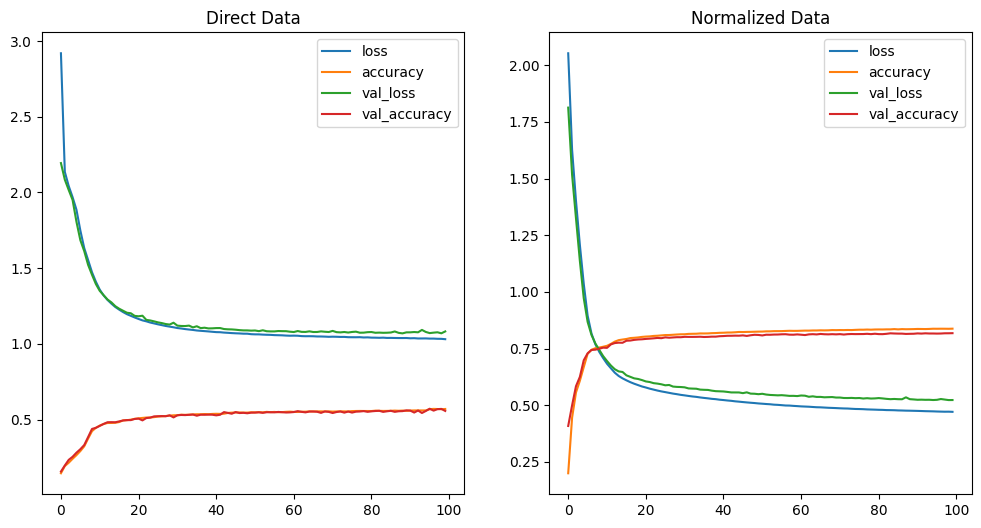
# confusion matrix
test_predictions = model_multiclass_norm.predict(test_data_norm)
confusion_norm = confusion_matrix(test_labels, np.argmax(test_predictions,axis=1))
confusion_norm
# the confusion matrix already starts to look promising
# array([[757, 1, 27, 101, 4, 4, 85, 0, 19, 2],
# [ 3, 945, 9, 36, 5, 0, 1, 0, 1, 0],
# [ 31, 3, 699, 10, 147, 0, 106, 0, 4, 0],
# [ 49, 11, 8, 853, 28, 0, 41, 0, 10, 0],
# [ 1, 3, 111, 36, 738, 0, 102, 0, 9, 0],
# [ 0, 1, 0, 1, 0, 895, 0, 53, 3, 47],
# [188, 4, 105, 62, 101, 0, 509, 0, 29, 2],
# [ 0, 0, 0, 0, 0, 42, 0, 926, 0, 32],
# [ 7, 2, 2, 11, 2, 4, 39, 5, 927, 1],
# [ 1, 0, 0, 0, 0, 18, 0, 52, 1, 928]])
Finding the Ideal Learning Rate
# add adaptive learning rate
tf.random.set_seed(42)
model_multiclass_norm_lr = tf.keras.Sequential([
tf.keras.layers.Flatten(input_shape=(28, 28), name="input_layer"),
tf.keras.layers.Dense(4, activation="relu", name="dense_layer1"),
tf.keras.layers.Dense(4, activation="relu", name="dense_layer2"),
tf.keras.layers.Dense(10, activation="softmax", name="output_layer")
])
model_multiclass_norm_lr.compile(loss=tf.keras.losses.SparseCategoricalCrossentropy(),
optimizer=tf.keras.optimizers.Adam(),
metrics=["accuracy"])
learning_rate_callback = tf.keras.callbacks.LearningRateScheduler(lambda epoch: 1e-4 * 10**(epoch/20))
model_multiclass_norm_lr_history = model_multiclass_norm_lr.fit(train_data_norm, train_labels,
callbacks=[learning_rate_callback],
validation_data=(test_data_norm, test_labels),
epochs=100, verbose=1)
# Epoch 100/100
# 1875/1875 [==============================] - 3s 2ms/step - loss: 3.1371 - accuracy: 0.0984 - val_loss: 2.4865 - val_accuracy: 0.1000 - lr: 8.9125
# get ideal learning rate by checking the lr decay curve
lr = 1e-4 * (10 ** (tf.range(100)/20))
plt.figure(figsize=(12, 7))
plt.title("Learning Rate Decay")
plt.xlabel("Learning Rate")
plt.ylabel("Loss")
plt.semilogx(lr, model_multiclass_norm_lr_history.history["loss"])
plt.show()
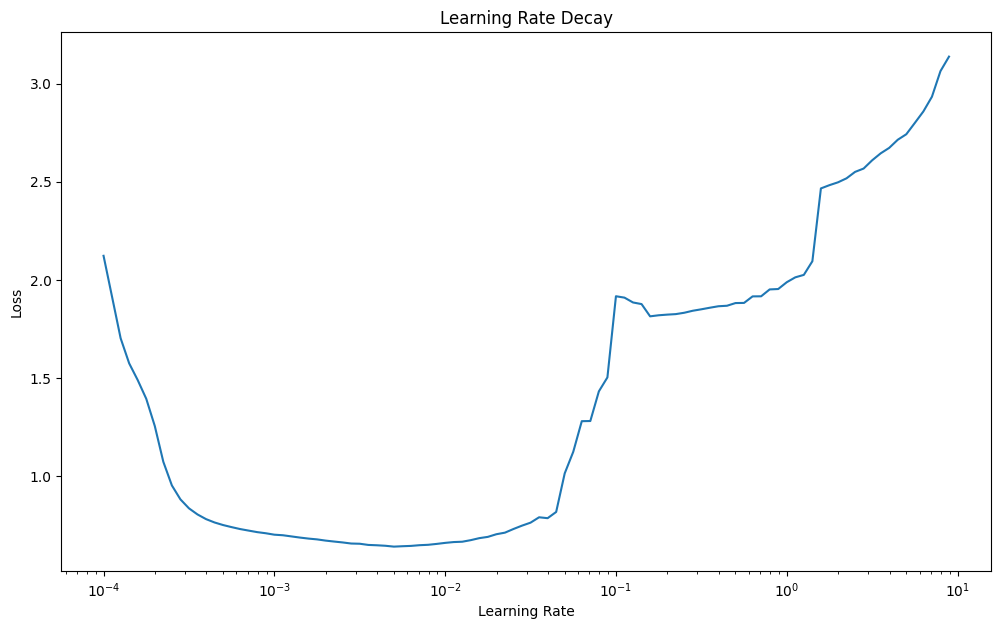
# the lowest point is at 4e-3 -> divide by 10
# the ideal learning rate is 4e-4 => model re-fit
tf.random.set_seed(42)
model_multiclass_norm = tf.keras.Sequential([
# flatten data from `28*28` to `None, 784`
tf.keras.layers.Flatten(input_shape=(28, 28)),
tf.keras.layers.Dense(4, activation="relu", name="input_layer"),
tf.keras.layers.Dense(4, activation="relu", name="dense_layer1"),
tf.keras.layers.Dense(10, activation="softmax", name="output_layer")
])
model_multiclass_norm.compile(loss=tf.keras.losses.SparseCategoricalCrossentropy(),
optimizer=tf.keras.optimizers.Adam(learning_rate=4e-4),
metrics="accuracy")
history_multi_norm = model_multiclass_norm.fit(train_data_norm, train_labels, batch_size=32,
validation_data=(test_data_norm, test_labels),
epochs=100, verbose=1)
# Epoch 100/100
# 1875/1875 [==============================] - 4s 2ms/step - loss: 0.5323 - accuracy: 0.8042 - val_loss: 0.6132 - val_accuracy: 0.7862
# plot confusion matrix
import itertools
def plot_confusion_matrix(y_pred, y_true, classes=None, figsize = (12, 12), text_size=7):
# create the confusion matrix
cm = confusion_matrix(y_pred, y_true)
# normalize
cm_norm = cm.astype("float") / cm.sum(axis=1)[:, np.newaxis]
# cm_norm
# array([[1., 0.],
# [0., 1.]])
number_of_classes = cm.shape[0]
# 2
# plot matrix
fig, ax = plt.subplots(figsize=figsize)
cax = ax.matshow(cm, cmap=plt.cm.Greens)
fig.colorbar(cax)
if classes:
labels = classes
else:
labels = np.arange(cm.shape[0])
# axes lables
ax.set(title="Confusion Matrix",
xlabel="Prediction",
ylabel="True",
xticks=np.arange(number_of_classes),
yticks=np.arange(number_of_classes),
xticklabels=labels,
yticklabels=labels)
ax.xaxis.set_label_position("bottom")
ax.title.set_size(15)
ax.xaxis.label.set_size(15)
ax.yaxis.label.set_size(15)
ax.xaxis.tick_bottom()
# colour threshold
threshold = (cm.max() + cm.min()) / 2.
# add text to cells
for i, j in itertools.product(range(cm.shape[0]), range(cm.shape[1])):
plt.text(j, i , f"{cm[i, j]} ({cm_norm[i, j]*100:.1f}%)",
horizontalalignment="center",
color="white" if cm[i, j] > threshold else "black",
size=text_size)
## start by running predictions on the test dataset
test_predictions_ideal = model_multiclass_norm.predict(test_data_norm)
## set class with highest probability to 1 - rest to zero
y_pred = tf.argmax(test_predictions_ideal,axis=1)
## plot the confusion matrix predictions vs true labels
plot_confusion_matrix(y_pred=y_pred, y_true=test_labels, classes=class_names)
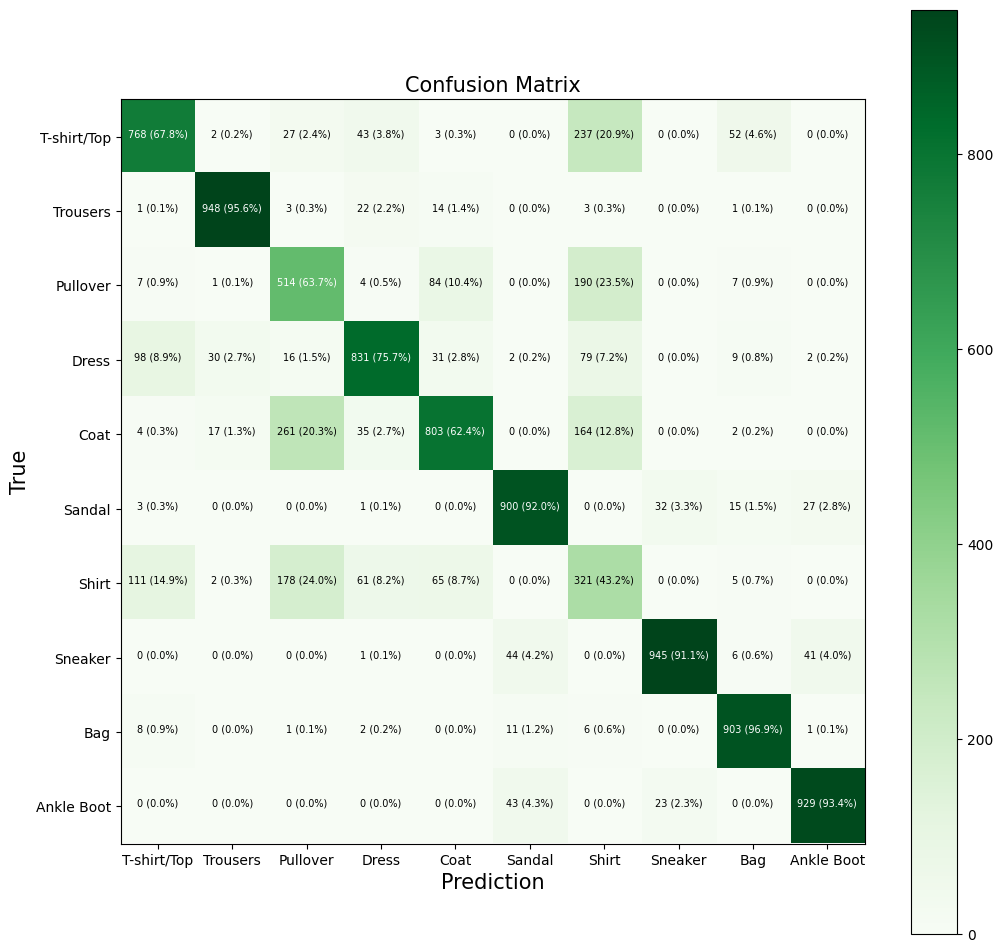
Making predictions to further evaluate the model
# function to pick a random image and run prediction
def random_image_prediction(model, images, true_labels, classes):
# create random image index
i = random.randint(0, len(images))
# select label of image at index i
true_label = classes[true_labels[i]]
# pick corresponding image
target_image = images[i]
# reshape image and pass it to prediction
pred_probabilities = model.predict(target_image.reshape(1, 28, 28))
# select class with highest probability
pred_label = classes[pred_probabilities.argmax()]
# plot the b&w image
plt.imshow(target_image, cmap=plt.cm.binary)
if pred_label == true_label:
color = "green"
else:
color = "red"
plt.xlabel("Prediction: {} {:2.0f}% (True: {})".format(pred_label,
100*tf.reduce_max(pred_probabilities),
true_label), color = color)
random_image_prediction(model=model_multiclass_norm,
images=test_data_norm,
true_labels=test_labels,
classes=class_names)
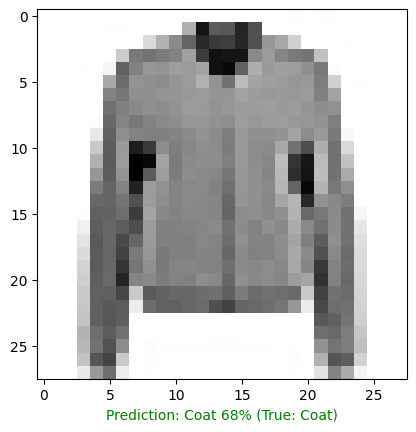
# function to pick a random image and run prediction
def random_image_map_prediction(model, images, true_labels, classes):
ran_gen = np.random.default_rng()
plt.figure(figsize=(12, 12))
for i in range(9):
# select random image
random_index = ran_gen.integers(low=0, high=len(images), size=1)
target_image = images[random_index[0]]
true_label = classes[true_labels[random_index[0]]]
# reshape image and pass it to prediction
pred_probabilities = model.predict(target_image.reshape(1, 28, 28))
# select class with highest probability
pred_label = classes[pred_probabilities.argmax()]
ax = plt.subplot(3, 3, i+1)
# plt.title(classes[train_labels[random_index[0]]])
if pred_label == true_label:
colour = "green"
colourmap = "Greens"
else:
colour = "red"
colourmap = "Reds"
plt.xlabel("Prediction: {} {:2.0f}% (True: {})".format(pred_label,
100*tf.reduce_max(pred_probabilities),
true_label), color = colour)
plt.imshow(target_image, cmap=colourmap)
plt.axis(True)
random_image_map_prediction(model=model_multiclass_norm,
images=test_data_norm,
true_labels=test_labels,
classes=class_names)
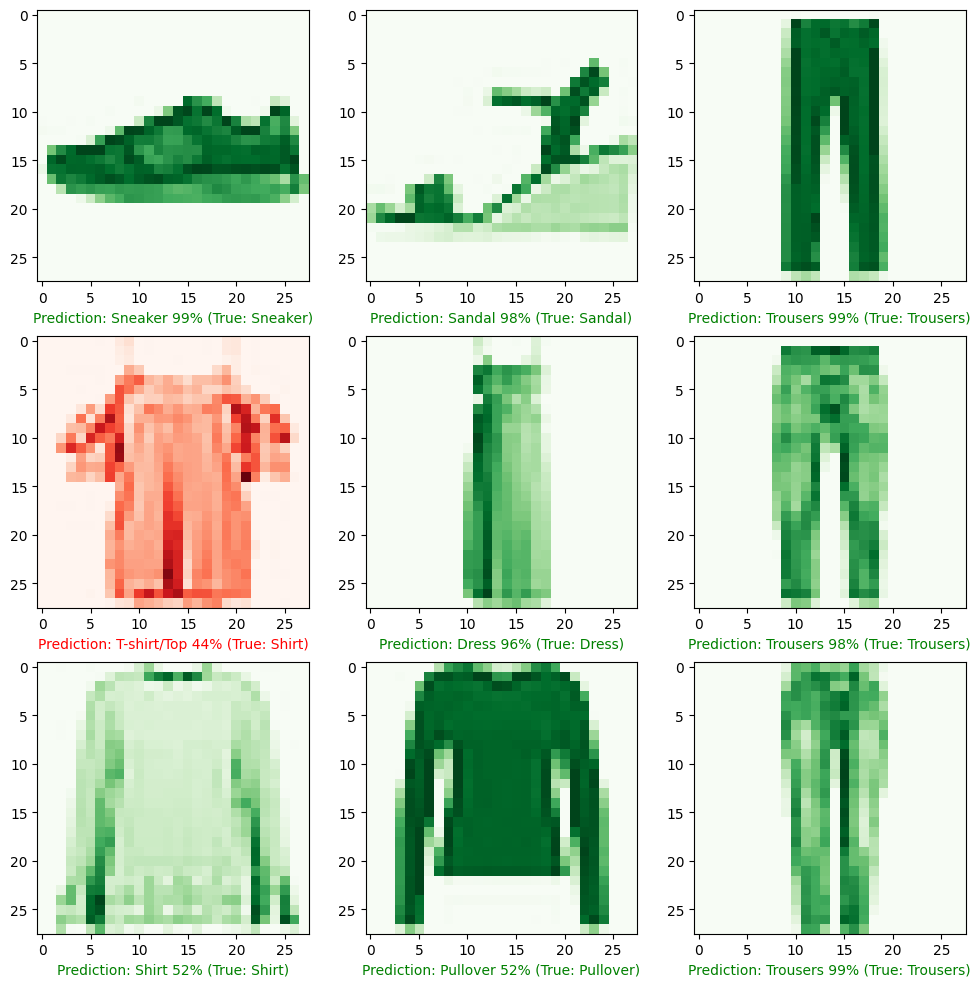
Weights & Biases
Weights represent the pattern a particular layer of our neural network has learned during training.
model_multiclass_norm.layers
# [<keras.layers.reshaping.flatten.Flatten at 0x7f0e24157940>,
# <keras.layers.core.dense.Dense at 0x7f0e2423e560>,
# <keras.layers.core.dense.Dense at 0x7f0eedc336d0>,
# <keras.layers.core.dense.Dense at 0x7f0e2423e620>]
# get weigths of a particular layer
weights, biases = model_multiclass_norm.layers[1].get_weights()
weights.shape, weights, biases.shape, biases, model_multiclass_norm.summary()
# weight.shape
# (784, 4)) => 28x28 for the image dimensions and 4 hidden units
# weights
# (array([[-1.3565315 , -0.3214511 , -0.16312897, -0.3301181 ],
# [-1.8619745 , 0.22111109, -1.3103486 , 1.1400424 ],
# [ 1.9727688 , -1.762827 , -1.5388335 , 0.39442703],
# ...,
# [ 0.5418353 , 0.5226571 , 0.27219778, 0.4796965 ],
# [-0.55814236, 0.2910452 , 0.26502737, 2.1195614 ],
# [-0.5417867 , -0.16617213, 1.1190995 , 0.3001483 ]],
# dtype=float32)
# for every pixel in our sample 28x28px images we get 4 different
# values from the 4 hidden units / neurons inspecting the image for features
# weights
# biases.shape => for every hidden unit we get a bias vector
# (4,),
# biases => dictate how much the corresponding weight should influence the next layer
# array([ 1.9621418 , 0.5325201 , 1.6395437 , -0.04142712], dtype=float32),
# None)
# model summary
# Model: "sequential_1"
# _________________________________________________________________
# Layer (type) Output Shape Param #
# =================================================================
# flatten_1 (Flatten) (None, 784) 0
# input_layer (Dense) (None, 4) 3140
# dense_layer1 (Dense) (None, 4) 20
# output_layer (Dense) (None, 10) 50
# =================================================================
# Total params: 3,210
# Trainable params: 3,210
# Non-trainable params: 0
# _________________________________________________________________